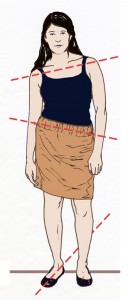 Many people suffer from a leg length discrepancy and this is almost always an issue with the tone of the psoas major rather than with the length of the bones of the skeleton. The body can be divided up in a number of ways—top and bottom, inside and out, back and front, and for today’s discussion, left and right. The legs, as I have written about before, follow a very cool 1, 2, 3, 4, 5 pattern of bones—one femur for the upper leg; two shin bones; three bones for the ankle; four for the mid-foot; and five toes. The coolest aspect of this pattern is that each bone on the opposite side is exactly the same length and breadth.
Many people suffer from a leg length discrepancy and this is almost always an issue with the tone of the psoas major rather than with the length of the bones of the skeleton. The body can be divided up in a number of ways—top and bottom, inside and out, back and front, and for today’s discussion, left and right. The legs, as I have written about before, follow a very cool 1, 2, 3, 4, 5 pattern of bones—one femur for the upper leg; two shin bones; three bones for the ankle; four for the mid-foot; and five toes. The coolest aspect of this pattern is that each bone on the opposite side is exactly the same length and breadth.
In rare cases people are born with bones of different sizes and very often traumatic injuries can affect the length of the bones; but for the most part the hard bits of our skeleton are equal to each other when they exist in pairs. So getting that out of the way leaves us with our psoas major muscle and its ability to wreak havoc on our bodies.
A tight psoas major can take on many patterns. A classic and I think primary pattern, is when the psoas both pulls the leg up into its hip socket at the bottom and pulls the rib cage down towards the hip at the top. I say primary because I think this is the first tightening pattern for all psoas. In some cases the assorted torque and pull on the spine and ribcage can get much more extreme leading to scoliosis and even a hunchback.
Everyone has a leg length discrepancy—it is merely a matter of degree. If you don’t know which one of your legs is shorter than the other here are a few things to look for to figure it out. Very often one foot turns out more than the other—that is your shorter leg. One hip is usually higher than the other- the higher hip is your shorter leg. One shoulder is often lower than the other—that side will be your shorter leg. If you have never observed these details about yourself spend some time looking in the mirror to explore your physical body.
Everyone should get to know themselves but to use one of my favorite quotes from the German writer Goethe, “Know myself. If I knew myself, I’d run away”. And I’ll throw in a Ben Franklin quote for good measure. “There are three things extremely hard: steel, a diamond, and to know one’s self.”
How to work with this discrepancy is another story entirely. One of my favorite psoas releases, Foot on a Block, addresses leg length discrepancy directly. You can do this release on your shorter side, or both sides, feeling what it is like to stand both before and after. It can be a fairly radical feeling even though the exercise only takes about thirty seconds.
There is another very important issue when it comes to leg length discrepancy and yoga practice. The shorter leg is the tighter leg which is not going to have the same range of motion as the looser leg. Many people are right handed and our dominant side is often our shorter side. This is a hypothetical but let’s say that your right side is tighter and the ability to stretch it is limited both physically and emotionally. Then you move to work your left side, or more open side, and the available stretch is deeper and feels better—so you dive into it.
Unfortunately, if you can relate to that feeling, you are likely increasing your imbalance and leg length discrepancy with every yoga pose that you do. It is very hard to approach the practice from the point of view of limiting yourself but everyone should really be stretching to the limit of their tighter side and be focusing on bringing the body into balance rather than just stretch both sides as much as you can.
Good luck with that.
